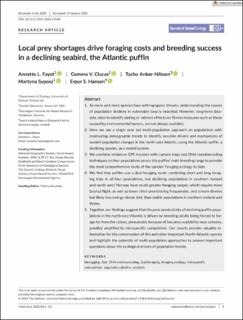| dc.description.abstract | 1. As more and more species face anthropogenic threats, understanding the causes of population declines in vulnerable taxa is essential. However, long-term datasets, ideal to identify lasting or indirect effects on fitness measures such as those caused by environmental factors, are not always available. 2. Here we use a single year but multi-population approach on populations with contrasting demographic trends to identify possible drivers and mechanisms of seabird population changes in the north-east Atlantic, using the Atlantic puffin, a declining species, as a model system. 3. We combine miniature GPS trackers with camera traps and DNA metabarcoding techniques on four populations across the puffins’ main breeding range to provide the most comprehensive study of the species' foraging ecology to date. 4. We find that puffins use a dual foraging tactic combining short and long foraging trips in all four populations, but declining populations in southern Iceland and north-west Norway have much greater foraging ranges, which require more (costly) flight, as well as lower chick-provisioning frequencies, and a more diverse but likely less energy-dense diet, than stable populations in northern Iceland and Wales. 5. Together, our findings suggest that the poor productivity of declining puffin populations in the north-east Atlantic is driven by breeding adults being forced to forage far from the colony, presumably because of low prey availability near colonies, possibly amplified by intraspecific competition. Our results provide valuable information for the conservation of this and other important North-Atlantic species and highlight the potential of multi-population approaches to answer important questions about the ecological drivers of population trends. biologging, diet, DNA metabarcoding, dual foraging, foraging ecology, intraspecific competition, population decline, seabirds | en_US |

